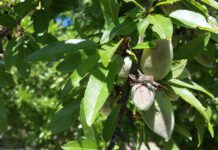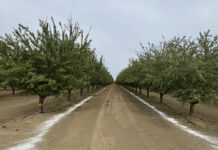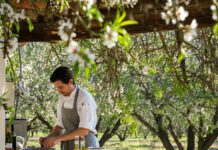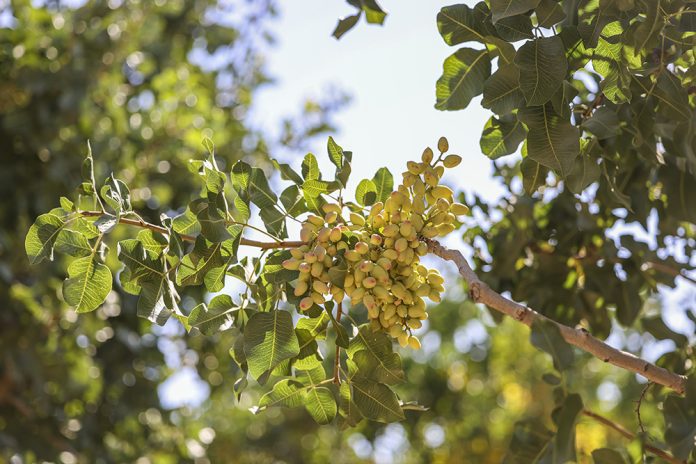
They say it takes a big man to admit when he’s wrong. That’s a lie. I’m only 5’ 7” and I am relatively sure 160 pounds doesn’t find itself anything past the low level of average. But I do stand corrected. Carbohydrates may not climb as high as we once thought during the postharvest period.
I have always tried my darnedest to make sure my growers push their chlorophyll production as far into fall as possible. I was under the assumption that every last bit of carbohydrate storage would make winter recovery and spring bloom that much more effective. And quite honestly, I still think so. But what I didn’t count on was the recent discovery that we may not get as much carbohydrate production as once thought after harvest. At the most recent California Pistachio Research Board (CPRB) meeting, we had this discussion involving zincing the leaves off our trees in the fall. It is a solid practice for young trees with an early onset winter and early fall freezing temperatures. The argument isn’t as valid for mature orchards but there were a couple things at play here.
Many growers were under the assumption heavy loads of zinc to toxic levels that “burnt” the leaves off were also influential in restoring zinc levels in the trees. There are two things in play here. When a tree experiences toxic levels of nutrients, it pushes them to the margins of the leaves. We see “burnt tips,” scorching and a desiccation. This happens as the tree is pushing those nutrients or antinutrients as far away from the core as possible. Zinc is critical in the abscission process and creating the means of “cutting” the leaf loose from the tree. Heavy, toxic shots of zinc don’t go into the tree as it tries to stop it before it moves through the phloem and into the branches. Hence the leaves cut themselves off, dry up and fall (think of it like drinking something awful.) It’s already in you if you took a sip, but it can still be spit out before its digested and in the blood stream. This zinc serves its purpose to shut the tree down and accelerate the dormancy, but it’s not feeding it.
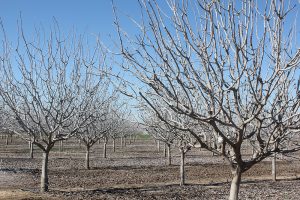
The second thing at play here is the practice of doing this for dormancy. And here’s where my “theory” doesn’t seem to hold as much water as previously thought. I have always tried to get my growers to hit postharvest with the nutrients to ramp up photosynthesis before dormancy to build carbohydrates for winter. I always push a little phosphorus to make ATP (energy), potassium to move the nutrients and take in carbon dioxide, a little nitrogen if we were deficient at harvest, and, most importantly, the central element of chlorophyl: magnesium for photosynthesis. The problem is Dr. “Z” at UC Davis has surmised the trees don’t actually store as much as originally hypothesized. At the CPRB meeting, I got confirmation of this from my good buddy and grower Joe Coelho. It was his opinion that carbohydrate storage was far less than we thought during this period.
What Does This Mean?
If you are short of any nutrients in your harvest tissues, there is still plenty of time to get them into your trees. You must stay up on that to maximize yields and orchard health. Having the right nutrients during spring bloom relies on this. It’s hard to make phosphorus available in some forms when it’s cold and wet. If you have young trees and a hard early winter is on its way, the last two weeks of delaying leaf drop with a toxic zinc application isn’t helping you like we thought. When the leaves do fall, any incorporation of them into the soil will also give you a more stable form of zinc locked up in that organic matter that should become available later in the new season. Depending on your outlook for weather, you should then be able to knock out winter sanitation earlier and get those mummies broken down sooner. With the disaster we had with navel orangeworm in almonds this year, anything any grower can do to lessen the pressure will help all crops affected.
And lastly, start your postharvest nutrition as early as possible for better assimilation before the trees shut down. I have many growers I consult start this process the last irrigation before harvest. We even sprayed a zinc foliar this year to help the abscission layer for better shaking. This will be a multi-year process to see if it worked as most trees shook very well this year in general.
We tend to stick to our convictions strongly based on our experiences, but we also must be able to look at the research and make new conclusions if the data says otherwise. It’s imperative to also know exactly what you are trying to accomplish with applications. A little discussion with the powers that be to confirm the physiology is supporting the theory will make us better growers. When the leaves fall off, it’s more fun to scare the crows in our field than eat one.



